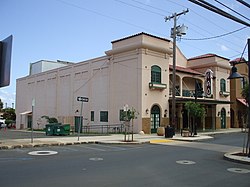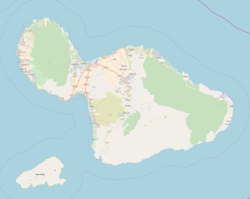The ʻĪao Theater is a Spanish Mission style theater opened in 1928, in the city of Wailuku, Maui, Hawaii. It was originally both a movie and vaudeville house, until it fell into disrepair in the 1980s. Facing possible demolition, in 1994, it was listed on the State of Hawaii's Register of Historic Places. It was placed on the National Register of Historic Places in 1995. It later became the home of Maui OnStage, a community-based theatrical organization.
ʻĪao Theater | |
 Looking from the Public Defenders Office, March 2010 | |
| Location | 68 North Market Street Wailuku, Hawaii |
|---|---|
| Coordinates | 20°53′20″N 156°30′07″W / 20.888990°N 156.502021°W |
| Area | Less than one acre |
| Built | 1928 |
| Architect | Edward Walsh |
| Architectural style | Mission/Spanish Revival |
| NRHP reference No. | 94001622[1] |
| HRHP No. | 50-50-04-01627[2] |
| Significant dates | |
| Added to NRHP | February 9, 1995 |
| Designated HRHP | June 24, 1994 |
History
editIn December 1927, Manuel Gomes Paschoal and H. B. Weller broke ground for Iao Theater on Market Street. The theater was designed by Edward Walsh. After nearly 9 months and $40,000 in construction costs, Iao Theater opened on August 22, 1928. The theater opened with a local play featuring local actors, and the showing of Sporting Goods starring Richard Dix at night.[3][4][5]
The theater was one of several theaters in Wailuku,[6] and was named after a small bait fish named the ʻiao.[a] Aside from screening movies, the theater also hosted live onstage performances. Notable events included appearances by Bob Hope, Betty Hutton, and Frank Sinatra for USO shows during World War II,[3] plus showed such movies as Rio Rita, and the X-rated film Deep Throat (which got the theater owner arrested).[4] In 1953, the Hawaii debut of From Here to Eternity was staged at the Iao.[4] A snack concession was run by Harry Kaya for almost 40 years, from 1930 to the mid-1970s, called Harry's Sweets. The location was just outside the main theater entrance.[5] Local Hawaiian music artists such as Kealiʻi Reichel and Amy Hanaialiʻi Gilliom also gathered experience at the Iao.[3]
By the early 1980s, after the theater closed down, the threat of demolition loomed. Maui Community theater first occupied the theater in 1984 for $200 a month,[3] and community efforts commenced to help save the Iao from demolition. In July 1993, Maui County paid $882,000 to buy the 1-acre (4,000 m2) site and the theater itself from the Lyons family trust after plans to demolish or convert the theater for other purposes materialized[b] and spent $1.8 million on a partial restoration.[7] The Hawaii State Register of Historic Places listed the Iao on June 24, 1994. It is the only surviving historic theater on Maui.[8] The Department of the Interior placed the theater onto the National Register of Historic Places on February 9, 1995.[1][8][9]
Modern usage
editAs of 2010[update], Maui Community Theater, doing business as Maui OnStage, uses the theater for various functions.[10] Redevelopment of the area also has included a 43 stall parking lot behind the theater.[11]
Gallery
edit-
The building in 2007.
-
Front facade
-
National Register Plaque affixed on the front of the building
-
Iao Theater front ticketing area
-
The Box Office
Notes
edit- a. ^ The book lists this reason, citing the theater was not named for Iao Valley.[5]
- b. ^ Maui News lists two contradicting plans in two separate articles; demolition to use the land for a shopping complex is referenced in one article [12] while an editorial lists conversion to offices as the reason that prompted Maui County to save the Iao Theater.[3]
References
edit- ^ a b "National Register Information System". National Register of Historic Places. National Park Service. January 23, 2007.
- ^ "Historic Register Counts". Hawai'i State Historic Preservation Division. State of Hawaii. February 1, 2022. Retrieved February 19, 2022.
- ^ a b c d e "Iao Theater rich in history". Maui News. May 29, 2005.
- ^ a b c "Iao Theater - A Brief History". Maui OnStage. 2005.
- ^ a b c Engebretson, George (2000). Exploring Historic Wailuku: Small Town Series Maui. Watermark Publishing. p. 50. ISBN 978-0-963-11543-0.
- ^ Bartholomew, Gail; Bailey, Bren (1994). Maui Remembers A Local History. Mutual Publishing. pp. 128, 131. ISBN 978-1-566-47069-8.
- ^ Jule Wind (March 23, 2006). "BACKSTAGE: Wailuku's Iao Theater at the crossroad ? again". Maui News.
- ^ a b HAWAI`I AND NATIONAL REGISTER OF HISTORIC PLACES - Maui Archived 2011-05-17 at the Wayback Machine
- ^ "Iao Theater". Historic Hawaii Foundation. Retrieved February 21, 2022.
- ^ "Maui OnStage - At the Historic Iao Theater". official web site. 2006. Retrieved October 7, 2010.
- ^ "43 parking stalls being added near Iao Theater". Maui News. October 19, 2004.
- ^ Melissa Tanji (September 15, 2006). "Lease issue raises questions, no answers". Maui News.

